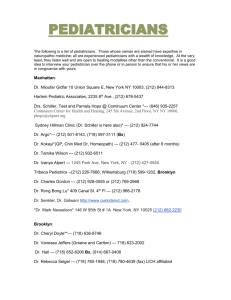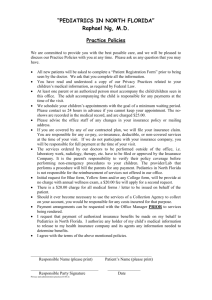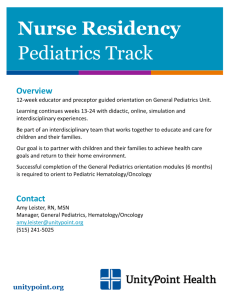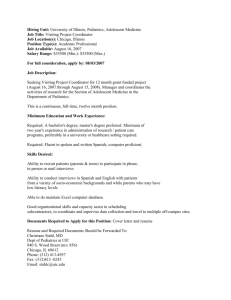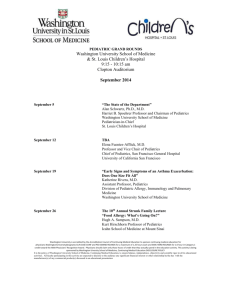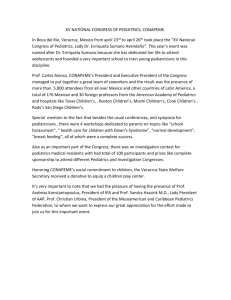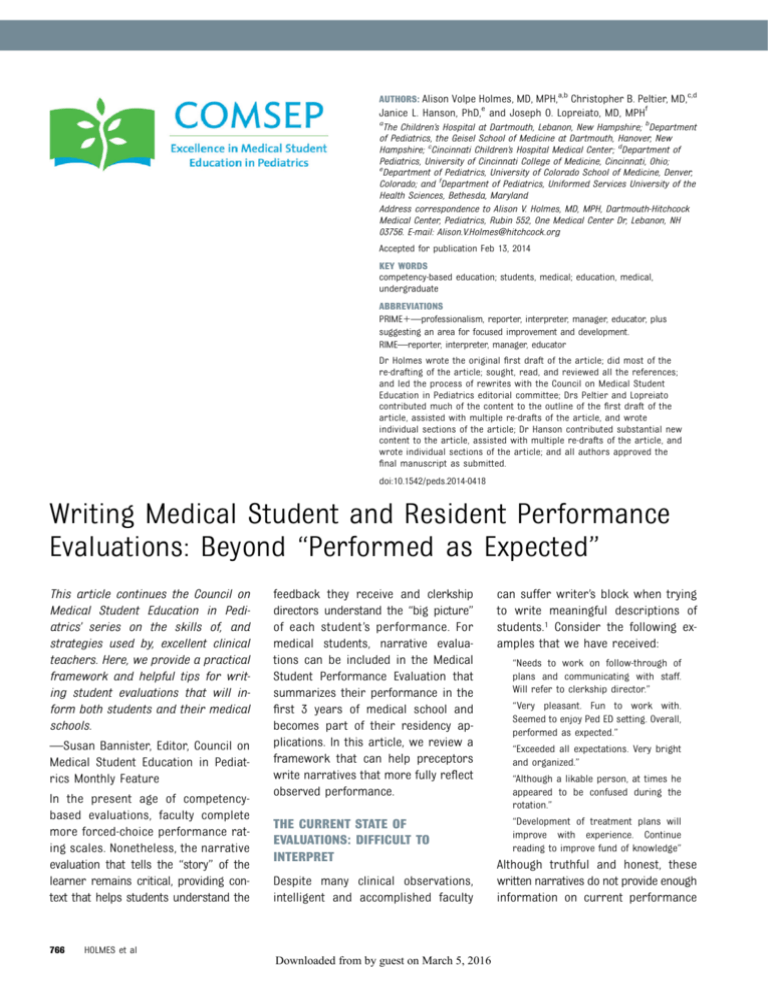
a,b
Christopher B. Peltier, MD,c,d
Janice L. Hanson, PhD,e and Joseph O. Lopreiato, MD, MPHf
AUTHORS: Alison Volpe Holmes, MD, MPH,
a
The Children’s Hospital at Dartmouth, Lebanon, New Hampshire; bDepartment
of Pediatrics, the Geisel School of Medicine at Dartmouth, Hanover, New
Hampshire; cCincinnati Children’s Hospital Medical Center; dDepartment of
Pediatrics, University of Cincinnati College of Medicine, Cincinnati, Ohio;
e
Department of Pediatrics, University of Colorado School of Medicine, Denver,
Colorado; and fDepartment of Pediatrics, Uniformed Services University of the
Health Sciences, Bethesda, Maryland
Address correspondence to Alison V. Holmes, MD, MPH, Dartmouth-Hitchcock
Medical Center, Pediatrics, Rubin 552, One Medical Center Dr, Lebanon, NH
03756. E-mail: Alison.V.Holmes@hitchcock.org
Accepted for publication Feb 13, 2014
KEY WORDS
competency-based education; students, medical; education, medical,
undergraduate
ABBREVIATIONS
PRIME1—professionalism, reporter, interpreter, manager, educator, plus
suggesting an area for focused improvement and development.
RIME—reporter, interpreter, manager, educator
Dr Holmes wrote the original first draft of the article; did most of the
re-drafting of the article; sought, read, and reviewed all the references;
and led the process of rewrites with the Council on Medical Student
Education in Pediatrics editorial committee; Drs Peltier and Lopreiato
contributed much of the content to the outline of the first draft of the
article, assisted with multiple re-drafts of the article, and wrote
individual sections of the article; Dr Hanson contributed substantial new
content to the article, assisted with multiple re-drafts of the article, and
wrote individual sections of the article; and all authors approved the
final manuscript as submitted.
doi:10.1542/peds.2014-0418
Writing Medical Student and Resident Performance
Evaluations: Beyond “Performed as Expected”
This article continues the Council on
Medical Student Education in Pediatrics’ series on the skills of, and
strategies used by, excellent clinical
teachers. Here, we provide a practical
framework and helpful tips for writing student evaluations that will inform both students and their medical
schools.
—Susan Bannister, Editor, Council on
Medical Student Education in Pediatrics Monthly Feature
In the present age of competencybased evaluations, faculty complete
more forced-choice performance rating scales. Nonetheless, the narrative
evaluation that tells the “story” of the
learner remains critical, providing context that helps students understand the
766
feedback they receive and clerkship
directors understand the “big picture”
of each student’s performance. For
medical students, narrative evaluations can be included in the Medical
Student Performance Evaluation that
summarizes their performance in the
first 3 years of medical school and
becomes part of their residency applications. In this article, we review a
framework that can help preceptors
write narratives that more fully reflect
observed performance.
THE CURRENT STATE OF
EVALUATIONS: DIFFICULT TO
INTERPRET
Despite many clinical observations,
intelligent and accomplished faculty
HOLMES et al
Downloaded from by guest on March 5, 2016
can suffer writer’s block when trying
to write meaningful descriptions of
students.1 Consider the following examples that we have received:
“Needs to work on follow-through of
plans and communicating with staff.
Will refer to clerkship director.”
“Very pleasant. Fun to work with.
Seemed to enjoy Ped ED setting. Overall,
performed as expected.”
“Exceeded all expectations. Very bright
and organized.”
“Although a likable person, at times he
appeared to be confused during the
rotation.”
“Development of treatment plans will
improve with experience. Continue
reading to improve fund of knowledge”
Although truthful and honest, these
written narratives do not provide enough
information on current performance
MONTHLY FEATURE
and do not specify areas for focused
attention in subsequent learning experiences.
A TOOL TO HELP WRITE BETTER
STUDENT EVALUATIONS
A widely used tool for improving written
evaluations was developed by Dr Louis
Pangaro at the Uniformed Services
University. Known as RIME, it classifies
important observable trainee behaviors
and skills into 4 easily observed domains: reporter, interpreter, manager,
and educator.2 In an individual clinical
encounter, learners may demonstrate
behaviors from several domains.3
THE RIME FRAMEWORK: A REVIEW
“R” for reporter refers to the student’s
ability to obtain information from a
patient or family interview, to review a
medical record, and to report findings
coherently in oral presentations and
written notes.
Interpreter is the “I” in RIME. This domain addresses how well a learner can
interpret data collected from the history,
physical examination, medical record,
laboratory data, and radiologic studies;
prioritize the most urgent problems;
and formulate a well-reasoned differential diagnosis.
RIME continues with “M” for manager.
As a manager, a student would formulate diagnostic and therapeutic patient plans and manage all aspects
of care for the most common complaints. Management includes performing simple procedures and managing
one’s own time.
The “E” in RIME is for educator, which
includes students’ abilities to educate
themselves via self-directed learning,
appropriately accepting and responding to feedback, and critical interpretation of the medical literature.
Students can teach by locating relevant articles, and also can teach
patients about health conditions.
RIME AND PRIME1
As Pangaro described reporter, interpreter,
manager, and educator, professionalism
was explicitly incorporated within
each domain.4 We propose the addition
of a “P” to RIME to specifically highlight professionalism; with this reminder, professionalism is less apt to
be omitted from written narratives.
The “P” reminds evaluators to incorporate comments about professionalism into each RIME domain. A “plus” at
the end reminds the evaluator to suggest an area for focused improvement
and development, giving students feedback that will help them progress along
the continuum of medical education.3,5,6
USING THE LANGUAGE OF PRIME1
IN WRITTEN NARRATIVES
Here are 2 good examples of narrative
comments that use the PRIME1
framework to provide useful descriptions of students’ performance. With
several descriptions like this, a clerkship director could assess a student’s
progress, provide meaningful feedback to the student about performance in the clerkship, and formulate
strong statements for the Medical
Student Performance Evaluation.
Jane was always on time, reliable, and
dependable such that I always knew the
information she provided was accurate.
She was able to report data succinctly
and gather complete histories while
simultaneously maintaining excellent
rapport with families. She performed
good differential diagnoses, was able to
interpret lab data, PFTs, etc, and to independently find resources to help her
when she came across data she had not
encountered previously. Jane could synthesize good plans, and managed patients
well, always spending additional time to
ensure family understanding of instructions. She responded well to feedback with
appreciation and an upbeat attitude,
worked diligently on fund of knowledge,
and was able to educate families and
patients well on various illnesses; always the professional, spending more
time and effort whenever it was required by the situation.
PEDIATRICS Volume 133, Number 5, May 2014
Downloaded from by guest on March 5, 2016
Professionally, John was prompt, appropriately groomed, friendly, and had
an energetic style much appreciated by
patients and staff. As a reporter, John
needs to continue to work on completeness and organization; excellent
efforts are made, but he can lose the big
picture by focusing on the wrong detail.
As an interpreter, he continues to have
short differentials and elementary understanding of how to organize and
evaluate complex, or multiproblem
patients. Manager skills are adequate,
as John generally did well calling back
patients and following up on labs and
studies, and did not fall behind on
documentation. He needs to continue to
develop longer-term planning for more
complex patients; having trouble synthesizing different aspects of psychosocial dimensions all pertaining to 1
patient. Educator: John reviewed a randomized trial on 2 different steroids in
the treatment of asthma. He seemed
minimally prepared and had only very
basic understanding of how to interpret
and use information from an RCT. Of
many potential areas of improvement,
would start in the reporter domain by
increasing details in histories, increasing completeness of histories, and
overall organization of presentations.
USING PRIME1 IN DAILY
PRACTICE
Once familiar with PRIME1, a busy
pediatrician can keep short daily notes
on learners in each of the domains.
Office-based preceptors, who often
work one-on-one with students, can use
these notes to give formative feedback
after each encounter or at the end of
the day. Hospital-based pediatricians can
keep a PRIME1 table of learners on
their team, and then use these organized
notes to write evaluations. Because RIME
domains relate directly to the work of
a physician, the framework helps a
preceptor organize observations from
daily work into a useful narrative. When
listening on rounds or reading notes,
teachers can assess reporter skills. In
taking an overnight phone call from a
student, one can note interpretation of
patient data. Manager skills can be
evaluated via timely completion of office
767
visits or in coordination of patient care.
In all interactions, the teacher can be
actively considering where the student
is in relation to curriculum goals, and
what he or she needs to do to progress
to the next level.
CONCLUSIONS
Written narratives can be challenging
to write and are critically important in
medical student and resident education. PRIME1 can provide structure
for observation, formative feedback,
and for writing summative evaluations
at the end of a clinical experience.
Using PRIME1 to structure your observations and evaluations, written narratives can be more effective, specific,
and meaningful.
REFERENCES
1. Lye PS, Biernat KA, Bragg DS, Simpson DE. A
pleasure to work with—an analysis of
written comments on student evaluations.
Ambul Pediatr. 2001;1(3):128–131
2. Pangaro L. A new vocabulary and other innovations for improving descriptive in-training
evaluations. Acad Med. 1999;74(11):1203–
1207
3. Pangaro L, Holmboe ES. Evaluation Forms
and Global Rating Scales. Practical Guide to
the Evaluation of Clinical Competence. Philadelphia, PA: Mosby Elsevier; 2008:24–41
4. Pangaro LN. A shared professional framework for anatomy and clinical clerkships.
Clin Anat. 2006;19(5):419–428
5. Hicks PJ, Schumacher DJ, Benson BJ, et al. The
pediatrics milestones: conceptual framework,
guiding principles, and approach to development. J Grad Med Educ. 2010;2(3):410–418
6. The Association of American Medical Colleges. AAMC Pediatric program focuses on
competency-based learning. Available at:
https://www.aamc.org/newsroom/newsreleases/
343836/05312013.html#.UrhA3yize2w. Accessed
December 23, 2013
FINANCIAL DISCLOSURE: The authors have indicated they have no financial relationships relevant to this article to disclose.
FUNDING: No external funding.
POTENTIAL CONFLICT OF INTEREST: The authors have indicated they have no potential conflicts of interest to disclose.
768
HOLMES et al
Downloaded from by guest on March 5, 2016
Writing Medical Student and Resident Performance Evaluations: Beyond
''Performed as Expected''
Alison Volpe Holmes, Christopher B. Peltier, Janice L. Hanson and Joseph O.
Lopreiato
Pediatrics 2014;133;766; originally published online April 14, 2014;
DOI: 10.1542/peds.2014-0418
Updated Information &
Services
including high resolution figures, can be found at:
/content/133/5/766.full.html
Post-Publication
Peer Reviews (P3Rs)
3 P3Rs have been posted to this article /cgi/eletters/133/5/766
Subspecialty Collections
This article, along with others on similar topics, appears in
the following collection(s):
Medical Education
/cgi/collection/medical_education_sub
Teaching/Curriculum Development
/cgi/collection/teaching_curriculum_dev_sub
Administration/Practice Management
/cgi/collection/administration:practice_management_sub
Practice-Based Learning & Development
/cgi/collection/practice-based_learning_-_development_sub
Permissions & Licensing
Information about reproducing this article in parts (figures,
tables) or in its entirety can be found online at:
/site/misc/Permissions.xhtml
Reprints
Information about ordering reprints can be found online:
/site/misc/reprints.xhtml
PEDIATRICS is the official journal of the American Academy of Pediatrics. A monthly
publication, it has been published continuously since 1948. PEDIATRICS is owned, published,
and trademarked by the American Academy of Pediatrics, 141 Northwest Point Boulevard, Elk
Grove Village, Illinois, 60007. Copyright © 2014 by the American Academy of Pediatrics. All
rights reserved. Print ISSN: 0031-4005. Online ISSN: 1098-4275.
Downloaded from by guest on March 5, 2016
Writing Medical Student and Resident Performance Evaluations: Beyond
''Performed as Expected''
Alison Volpe Holmes, Christopher B. Peltier, Janice L. Hanson and Joseph O.
Lopreiato
Pediatrics 2014;133;766; originally published online April 14, 2014;
DOI: 10.1542/peds.2014-0418
The online version of this article, along with updated information and services, is
located on the World Wide Web at:
/content/133/5/766.full.html
PEDIATRICS is the official journal of the American Academy of Pediatrics. A monthly
publication, it has been published continuously since 1948. PEDIATRICS is owned,
published, and trademarked by the American Academy of Pediatrics, 141 Northwest Point
Boulevard, Elk Grove Village, Illinois, 60007. Copyright © 2014 by the American Academy
of Pediatrics. All rights reserved. Print ISSN: 0031-4005. Online ISSN: 1098-4275.
Downloaded from by guest on March 5, 2016

